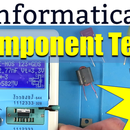Introduction: Digital Multimeter Kit Build DT830B DMM - Electronic Beginners Project
Here I show how to make one of the essentials for the electronics hobby, a digital multimeter. The kit does not have instructions so I show how to make it and then calibrate against my Fluke meter.
The kit is available on this link: DT830B Digital Multimeter Kit
The DMM can measure:
DC voltage: 200mV-1000V (0.5% +2 dgt)
AC voltage: 200-750V (1.2% +10 dgt)
DC current: 200uA-10A (1.0% +2 dgt)
Resistance: 200Ω-2MΩ (0.8% +2 dgt)
The kit comprises of a PCB containing the main DMM Integrated Circuit. The PCB is clearly marked with the component values. The resistors are nicely laid out on a card with the resistance value and circuit reference. The circuit diagram is included. There is a bag containing the other components and hardware. Finally an LCD display with connecting elastomer and a plastic case with stick on decal. The complete build is shown in the video and in the steps below.
Step 1: Solder the Resistors
With most kit builds the first components to solder are the lowest profile on the board, usually the resistors. They are all identified on the card and the only thing to note is that there are two 900 ohm resistors with different tolerances. The 0.15 % resistor goes in the location shown in the photo. Also note that there is a short piece of copper wire in the kit which is the 0.01 ohm resistor used to measure the current.
Step 2: Solder the Capacitors
There are only a few capacitors to install and I highly recommend using a component tester to check the values if you are unsure. I use this tester Multi-function Tester
There are two 200 nF capacitors in the kit but they are marked on the PCB as 154P, don't worry they seem to work!
Step 3: Fitting the Transistor Test Socket
It is not immediately obvious on which side of the PCB this goes or it's orientation. It fits on the side of the PCB with the switch contacts. Line up the ridge on the socket with the indent in the front of the case to get the correct orientation.
Step 4: A Note About Soldering
To solder the metal test sockets and the fuse holder, make sure you have a soldering iron of at least 30 Watts. A small soldering iron may struggle to produce enough heat and result in a bad solder joint. Not something you want for test equipment!
Step 5: Fitting the Switch Contacts
The copper switch wiper contacts fit over the plastic "bridges" in the center of the switch. Just gently press them in place.
Step 6: Final Assembly
First place the small springs in the holes on the switch with the small ball bearings on top. These act as the detents that locate the switch contacts in their correct place. Next put the LCD in place with the pink elastomer, there is a slightly raised section in the plastic case that indicates where the elastomer sits. Place the PCB on top and secure with the four small screws provided. Carefully fit the battery noting the correct polarity, the spring contact at the bottom is the battery positive. You're nearly done!
Step 7: Test and Calibration
Switch the DMM to DC volts and the display should show zeros. Move the dial around to check the other ranges.
Calibrate the DMM against a known good DMM by adjusting the small potentiometer on the PCB.
You're done! Congratulations on your new piece of test gear, may it serve you well for many years!













